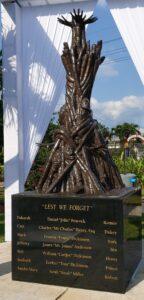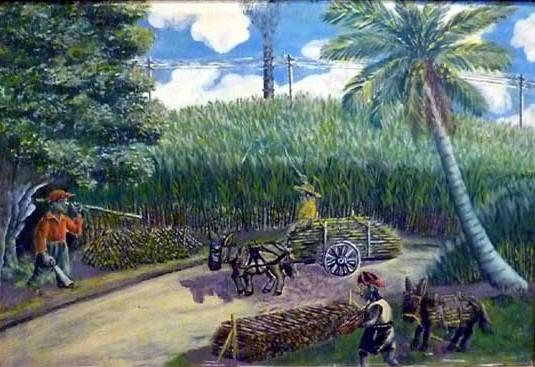A book and a monument, “Lest We Forget”

On 27 February, I attended the unveiling of the Lest We Forget monument at the Joy Spence Appleton Rum Experience in Nassau Valley, St Elizabeth. The monument, which commemorates the persons who were enslaved at Appleton, was designed and executed by a young Jamaican sculptor, Trishaunna Henry, who had won the design competition for the memorial last year. The unveiling of the monument followed on the 9 February launch of the book Appleton Estate: From the Dickinson Family to the Campari Group, A Short History. The book was researched and written by Verene Shepherd, Ahmed Reid, Gabrielle Hemmings and John Shorter, who are associated with the Centre for Reparation Research of the University of the West Indies. It was produced as a commission from J. Wray and Nephew Limited, and published by Ian Randle Publishers.
As the book reminds us, it all started with a letter to the editor, which was published as Letter of the Day in the Gleaner of 13 July 2018. The letter, by one V.T. from London, UK, lamented the Disneyfied representation of plantation history in the Appleton tour and the lack of reference to the presence and experiences of the enslaved. The letter caused quite a stir at the time, leading to a broader discussion about how the history of slavery is glossed over in the Jamaican tourism industry.

Interestingly, J. Wray and Nephew and the Campari Group, which had acquired J. Wray and Nephew and its subsidiary, Appleton in 2012, took on board the criticism and invited the Centre for Reparation Research of the University of the West Indies to review the Appleton tour experience. The book and monument are products of that initiative. The research delved deeply into the archives, here in Jamaica and in the UK, but the book makes for rather dry reading, as it is focused on the economic history of Appleton and far less so on the experience of the enslaved, which is discussed with significant restraint. In studies like this, however, the tables and diagrams often speak more eloquently than the text itself. Table 3.3., for instance, outlines the “relative value of the productive factors: Appleton Estate, 1760” and lists 100 slaves valued at 45 pounds each and while this is higher than the livestock listed, their joint appearance on the cold and objective table also speaks volumes about the dehumanizing and exploitative nature of chattel slavery. The book also drives home, indirectly, how power and money in Jamaica and the UK today remains rooted in the plantocracy.
One of the recommendations in the conclusion to the book was that there should be a memorial to the persons who were enslaved at Appleton. This resulted in a competition for the design of such a memorial, which was launched last year. I must admit that I was initially rather sceptical of the initiative, because I assumed that the commission would go to one of the “usual suspects”. I was surprised and delighted that the jurors selected a young Jamaican woman artist, who is still below 30 years, and who is not a part of the well-connected social cohorts that typically receive major public art commissions in Jamaica. Trishaunna is a former student of mine at the Edna Manley College, which only added to my delight.

I will leave a more detailed discussion of Trishaunna’s other work for a future occasion, but it is of note that she is essentially a figurative sculptor whose work is preoccupied with notions of hybridity. Her design for Lest We Forget is, not surprisingly, a hybrid form, in which partially visible figures are entrapped in an intertwined bunch of sugarcane, to the point of being part of it, but are also resisting the confinement and ultimately achieve transcendence, as the upward movement of the structure and the upward reaching hands at the top suggest. As Trishaunna states in the accompanying text panel: “The monument is inspirational and aspirational in that it shows the potential for self-actualization from the trauma of these experiences. The monument is, therefore, meant to lift our spirits without romanticizing the trauma…” There is a raw sense of pathos in the imagery, which is indeed unsparing in its depiction of anguish, but the subject arguably calls for that.
The artist’s insistence that there is, as the text panel also tells us, an “inseparable relationship between sugarcane and the socio-cultural and economic development of Jamaica” also reminded me of how this relationship has been represented in the work of other Caribbean artists. I was particularly thinking of the Cuban painter Wifredo Lam, particularly in his best-known painting The Jungle (1943), where the plantation is represented as a site haunted by an oppressive and exploitative history but also a powerful incubator of African-derived spiritual resistance and various other acts of self-liberation.
It was difficult to get a good view (or good photographs) of the monument at the unveiling, because of the crowd and the temporary ceremonial structure that had been built around it, but I was left with a few technical concerns. While it has a bronze finish, I was surprised and rather concerned to learn the statue itself was fabricated from resin. Casting in bronze is expensive and organizationally challenging, whether it is done locally or abroad, but resin is no match the tropical environment and will likely begin to deteriorate in a few years. I can only hope that the monument will eventually be cast in bronze, so that its longevity is ensured.
I also had mixed feelings about the base. The inclusion of names of persons who had been enslaved at Appleton is an essential part of the monument’s concept, and powerfully reclaims their humanity and individuality in defiance of a system that exploited and dehumanized them. The base is, however, made from the sort of dark, shiny natural stone, with gilded lettering, that is more typically seen at a cemetery and clashes visually and materially with the rest of the monument. The base certainly could have been more effectively integrated, technically and aesthetically, into the final design and execution of the monument.
While the book and monument commissions are highly commendable, and will hopefully be emulated by other entities with similar histories in Jamaica, the project is also mired in contradictions that are unavoidable at the intersection of tourism, history and business. The monument is part of a tourist attraction, and it is perhaps no small irony that the history and experience of slavery is now arguably commodified in that context. I could not find the cost to attend the Joy Spence Appleton Rum Experience, but I gather that the ticket prices are not cheap, even for local visitors. The monument will, therefore, never be seen by the majority of Jamaicans, while the island has very few monuments that speak to the slavery experience that are truly in the public domain and accessible to all. As was mentioned in one of the speeches at the unveiling, the arrival point monument on the Kingston Waterfront has been in limbo for many years and the time may indeed be right to revive that project.
Dr Veerle Poupeye is an art historian specialized in art from the Caribbean. She works as an independent curator, writer, researcher, and cultural consultant. The second, revised and expanded edition of her best-known book “Caribbean Art” was recently published in the World of Art series of Thames and Hudson. Her personal blog can be found at veerlepoupeye.com.






